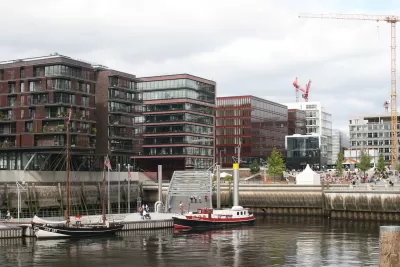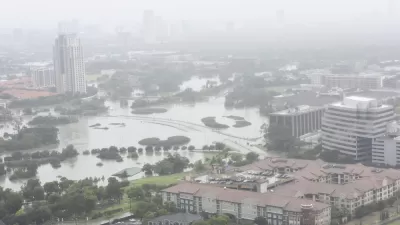A riverside neighborhood in Hamburg embraces flooding as part of its resilience planning, using old techniques to protect modern communities.

HafenCity, a development in the German port city of Hamburg, sits outside the city's main flood protection dike. Yet the community is being hailed as "a model for climate change resilience," writes Peter Yeung, thanks to its innovative use of centuries-old techniques that mitigate the effects of flooding, which is anticipated to become more severe as extreme weather worsens.
Rather than fight the flooding, some of HafenCity's structures, like the public promenades along the river and retrofitted brick warehouses, are built to withstand being flooded. "It’s a dramatic example of how a city can plan new development around the certainty of future flooding. While Hamburg sits more than 100 kilometers from the North Sea, its lowlands are vulnerable both to storm surges and heavy rainfall."
While most of the city is protected by a dike, HafenCity fell outside the area which could reasonably and affordably be integrated into the dike's domain. Its designers used another ancient Dutch technique: the terp. "Based on an ancient Dutch technique for building atop artificial mounds, the practice predates the modern era of seawalls" and promotes "[t]he concept of living with water rather than attempting to wall it off." The practice is also used in other parts of Hamburg to mitigate seasonal flooding. These strategies are coupled with a Storm Surge Warning Service that broadcasts announcements and provides information in the event of more unpredictable, catastrophic events.
Hamburg's success provides useful lessons for flood adaptation strategies that "focus on flexible, multi-use designs that are nature-based."
FULL STORY: In Hamburg, Surviving Climate Change Means Living With Water

Planetizen Federal Action Tracker
A weekly monitor of how Trump’s orders and actions are impacting planners and planning in America.

Chicago’s Ghost Rails
Just beneath the surface of the modern city lie the remnants of its expansive early 20th-century streetcar system.

San Antonio and Austin are Fusing Into one Massive Megaregion
The region spanning the two central Texas cities is growing fast, posing challenges for local infrastructure and water supplies.

Since Zion's Shuttles Went Electric “The Smog is Gone”
Visitors to Zion National Park can enjoy the canyon via the nation’s first fully electric park shuttle system.

Trump Distributing DOT Safety Funds at 1/10 Rate of Biden
Funds for Safe Streets and other transportation safety and equity programs are being held up by administrative reviews and conflicts with the Trump administration’s priorities.

German Cities Subsidize Taxis for Women Amid Wave of Violence
Free or low-cost taxi rides can help women navigate cities more safely, but critics say the programs don't address the root causes of violence against women.
Urban Design for Planners 1: Software Tools
This six-course series explores essential urban design concepts using open source software and equips planners with the tools they need to participate fully in the urban design process.
Planning for Universal Design
Learn the tools for implementing Universal Design in planning regulations.
planning NEXT
Appalachian Highlands Housing Partners
Mpact (founded as Rail~Volution)
City of Camden Redevelopment Agency
City of Astoria
City of Portland
City of Laramie





























